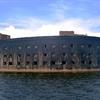Fortifications are military constructions or buildings designed for the defense of territories in warfare, and also used to solidify rule in a region during peace time. Humans have constructed defensive works for many thousands of years, in a variety of increasingly complex designs. The term is derived from the Latin fortis ("strong") and facere ("to make").
Fortifications
-
 1
1Capalna Dacian fortress
Situated at the top of a steep hill, the Dacian fortress of Capalna was built in the second half of the 1st century BC as a military defense, guarding the entrance from the Sebes Valley to the capital of the Dacian kingdom, Sarmizegetusa Regia.
-
 8
8Capela de Nossa Senhora da Guia, Guia Fortress, Macau
The chapel was built around 1622 inside the Guia Fortress. In 1998, frescoes were uncovered in the chapel during routine conservation work, representing both western and Chinese themes.
-
 10
10Casemates Muiden-West, Defence Line of Amsterdam
Developments in warfare during the Franco-Prussian War of 1870 prompted another round of upgrades and the construction of forts part of the Stelling van Amsterdam, Casemates Muiden-West.
-
 5
5Cathcart Tower, Kingston, Ontario
Cathcart Tower is a Martello tower located on Cedar Island in the St. Lawrence River, off the eastern shore of Fort Henry in Kingston, Ontario, Canada. It is one of four such towers built in the 1840s to protect Kingston's harbour and the entrance to the Rideau Canal. The other towers are: Fort Frederick, Shoal Tower, and Murney Tower.
-
 7
7Cetatea Lita Fortress (Ruins)
Cetatea Lita is a medieval fortress built on a cliff above the valley again. Documented in 1324 under the name "Castrum leta", the city had a very troubled past
-
 2
2Cilurnum (Chester's Roman For), Hadrian's Wall
Cilurnum or Cilurvum was a fort on Hadrian's Wall mentioned in the Notitia Dignitatum. It is now identified with the fort found at Chesters near the village of Walwick, Northumberland, England. It was built in 123 AD, just after the wall's completion.
-
 4
4Citadel (Fortifications of Vauban), Arras
Built by Vauban between 1667 and 1672, the Citadel has been nicknamed La belle inutile (the beautiful useless one) by residents as it has never been directly involved in heavy fighting and didn't prevent the Germans from occupying the city in either World War.
-
 7
7Citadel (Fortifications of Vauban), Besancon
The Citadel of Besancon in Franche-Comte, France, is one of the finest masterpieces of military architecture designed by Sebastien Le Prestre de Vauban.
-
 9
9Citadel of Derbend
Derbent resembles a huge museum and has magnificent mountains and shore nearby.
-
 10
10Citadel of Erbil
The Erbil Citadel is a tell or occupied mound, and the historical city centre of Erbil in the Kurdistan Region of Iraq. It has been claimed that the site is the oldest continuously inhabited town in the world.
-
 6
6Citadel of Severin
The Medieval Citadel of Severin that overlooks the Danube has three possible origins attributed to its name, the first being associated with the name of Roman Emperor Lucius Septimius Severus, another coming from the Slavic word 'severnai' that translates into 'northern', and the last being religious, alluding to Severin of Noricum the patron saint of the medieval Latin church discovered within the ruins of the citadel.
-
 10
10Citadel of the Ho Dynasty
Citadel of Ho Dynasty is a citadel in Vietnam, constructed by the Ho Dynasty (1400-1407).
-
 10
10City Walls, Essaouira
City Walls, Essaouira (Mogador). Essaouira old fortified walls.
-
 3
3Dacian Fortress, Mala Kopania
Dacian Fortress (it was a Dacian fortified town) in Mala Kopania, Ukraine.
-
 1
1Dar Soltane Palace & Fort (Ruins), Essaouira
Ruins of Dar Soltane Palace & Fort built For Mohammed Ben Abdallah, Essaouira, Atlantic Coast, Morocco.
-
 1
1Defensive tower, Sveti Stefan islet
Defensive tower on Sveti Stefan islet and hotel resort in Montenegro, approximately 6 kilometres (3.7 mi) southeast of Budva.
-
 1
1Dezsovar Fortress (Ruins), Gyongyossolymos
Dezsovar Fortress (Ruins), Gyongyossolymos. The Dezsovar was the smallest fortress. Inside area of 15x10 meters. Dezsovar Fortress is not available.
-
 10
10Diyarbakir Fortress
Diyarbakir Fortress, is a historical fortress in Sur, Diyarbakır, Turkey. It consists of inner fortress and outer fortress.
-
 5
5Fagaras Citadel
Built in 1310, Fagaras citadel was transformed in the first half of the 17th century from a military fortress back into a lordly citadel.
-
 1
1Fetele Albe Dacian fortress
Fetele Albe is a Dacian fortified settlement on the southern side of Muncelului Hill, situated north of Sarmizegetusa Regia, separated from it by a sharp declivity.
-
 4
4Finis Fortress (Ruins)
Finis Fortress (Belovar), Bihor county, Crisana, Romania - Finis Fortress (Belovar) is situated at the border of the Finis village, on top of a small peak.
-
 10
10Fort Alexander
Fort Alexander, also Fort Alexander I, or Plague Fort is a naval fortress on an artificial island in the Gulf of Finland near St. Petersburg and Kronstadt. In 1899–1917, the fort housed a research laboratory on plague and other bacterial diseases.
-
 10
10Fort along Den Ham, Northwest front, Defence Line of Amsterdam
The Fort along Den Ham is a fort that is part of the UNESCO World Heritage site of the Stelling van Amsterdam. It's located along the railroad from Uitgeest to Krommenie. The earthen walls date from 1896, the fort itself was finished in 1903.
-
 10
10Fort along Jisperweg, North front, Defence Line of Amsterdam
In 1885 the fort was completed as a defendable earthwork. It was not until 1914 that the fortress reached its final completion, though, when the construction of the shellproof building was finished.
-
 10
10Fort along Middenweg, North front, Defence Line of Amsterdam
The function of the Fort along Middenweg was to defend the access that was formed by the Middenweg and Zuiderweg roads. In 1885 the fort was completed as a defendable earthwork. It was not until 1914 that the fortress reached its final completion, though, when the construction of the shellproof building was finished.


